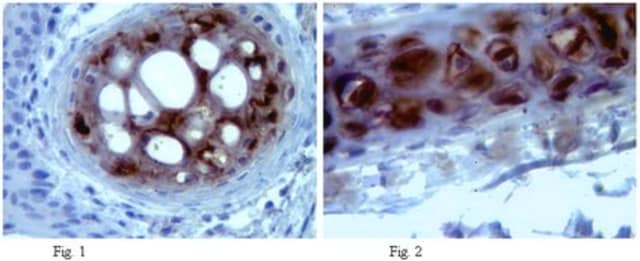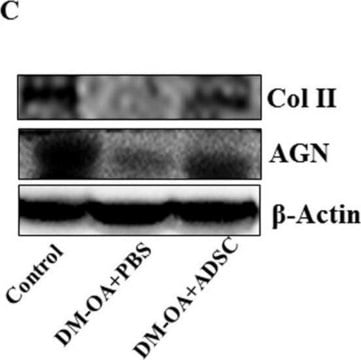MAB19310-C
Anti-Aggrecan Antibody, MMP Cleaved, clone AF-28, Ascites Free
clone AF-28, from mouse
Synonim(y):
Aggrecan core protein, MMP-cleaved, Cartilage-specific proteoglycan core protein, MMP-cleaved, Chondroitin sulfate proteoglycan 1, MMP-cleaved, Chondroitin sulfate proteoglycan core protein 1, MMP-cleaved, CSPCP, MMP-cleaved
About This Item
Polecane produkty
pochodzenie biologiczne
mouse
Poziom jakości
forma przeciwciała
purified immunoglobulin
rodzaj przeciwciała
primary antibodies
klon
AF-28, monoclonal
reaktywność gatunkowa
bovine, porcine, human, rat, mouse
metody
immunohistochemistry: suitable (paraffin)
western blot: suitable
izotyp
IgG1κ
numer dostępu NCBI
numer dostępu UniProt
Warunki transportu
wet ice
docelowa modyfikacja potranslacyjna
unmodified
informacje o genach
human ... ACAN(176)
Opis ogólny
Specyficzność
Immunogen
Zastosowanie
Immunohistochemistry Analysis: A representative lot detected MMP-cleaved aggrecan in paraffin-embedded tibia sections from both wild-type mice and mice with decreased MMP-13 expression (Zhou, X., et al. (2010). Proc. Natl. Acad. Sci. U. S. A. 107(29):12919-12924).
Western Blotting Analysis: A representative lot detected a higher level of MMP-generated FFGV fragments in osteoarthritis/osteoarthritic (OA) cartilage than in normal cartilage samples (Struglics, A., and Hansson, M. (2012). Biochem. J. 446(2):213-223).
Western Blotting Analysis: A representative lot detected MMPs-digested G2 fragment from recombinant G1-G2, but not undigested, elastase- or trypsin-digested fragments (Mercuri, F.A., et al. (1999). J. Biol. Chem. 274(45):32387-32395).
Western Blotting Analysis: A representative lot detected MMP-13-digested fragments from human, pig, bovine and rat, but not shark, aggrecan. Clone AF-28 did not detect undegraded aggrecan (Fosang, A.J., et al. (1996). FEBS Lett. 380(1-2):17-20).
Western Blotting Analysis: A representative lot detected in vitro generated aggrecan fragments by MMPs, as well as various aggrecan fragments in arthritis patients-derived synovial fluids (Fosang, A.J., et al. (1995). Biochem. J. 310( Pt 1):337-343).
Cell Structure
ECM Proteins
Jakość
Western Blotting Analysis: 0.5 µg/mL of this antibody detected MMP-cleaved aggrecan in 10 µg of human chondrocyte tissue lysate.
Opis wartości docelowych
Postać fizyczna
Przechowywanie i stabilność
Inne uwagi
Oświadczenie o zrzeczeniu się odpowiedzialności
Not finding the right product?
Try our Narzędzie selektora produktów.
polecane
Kod klasy składowania
12 - Non Combustible Liquids
Klasa zagrożenia wodnego (WGK)
WGK 1
Certyfikaty analizy (CoA)
Poszukaj Certyfikaty analizy (CoA), wpisując numer partii/serii produktów. Numery serii i partii można znaleźć na etykiecie produktu po słowach „seria” lub „partia”.
Masz już ten produkt?
Dokumenty związane z niedawno zakupionymi produktami zostały zamieszczone w Bibliotece dokumentów.
Nasz zespół naukowców ma doświadczenie we wszystkich obszarach badań, w tym w naukach przyrodniczych, materiałoznawstwie, syntezie chemicznej, chromatografii, analityce i wielu innych dziedzinach.
Skontaktuj się z zespołem ds. pomocy technicznej








